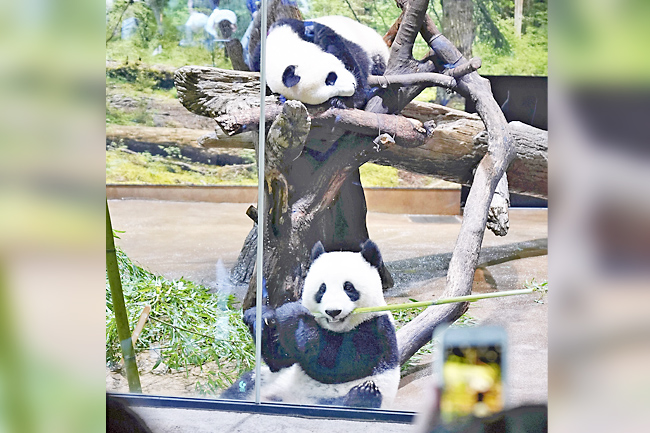Tomoki Masuda
THE WASHINGTON POST – Friday marked 50 years since giant pandas first arrived in Japan from China.Fifteen pandas have been raised at Ueno Zoo in Tokyo’s Taito Ward since then, including twin cubs – male Xiao Xiao and female Lei Lei born in June last year.
Those who have been closely watching their growth for half a century said they hope pandas will continue to be a symbol of Ueno.
In 1972, Kang Kang and Lan Lan were delivered to Japan as a gift from China to commemorate the normalisation of the two countries’ diplomatic relations.
A five-metre-high “panda balloon”, made using a balloon of a polar bear with parts painted black, was set up in Ueno Park. “It must have been a frantic time because no one had seen real pandas,” recalled 62-year-old jewellery shop owner and vice president of the Ueno-Nakadori shopping street promotion association near the zoo, Masahiro Kayano.
When Kang Kang and Lan Lan were put on display, Kayano joined the crowds waiting in line to see them. Kayano said he was able to see them only for a few seconds as he was jostled by the crowds of people but immediately was captivated by the fluffy, adorable animals.

The number of visitors to the zoo, usually between three million to four million annually, exceeded seven million in the fiscal 1973. The local shopping district which used to be filled with mostly residents was suddenly packed with tourists and visitors, and many stylish coffee shops and restaurants opened.
After Ling Ling died in 2008 following unsuccessful breeding efforts, leaving the zoo without a panda, the number of visitors to the zoo quickly dwindled. Some children were said to have cried when they found out there were no pandas only after they arrived.
Then Tokyo Governor Shintaro Ishihara was not interested in accepting another panda from China, saying, “It doesn’t matter if they are here or not.”
Alarmed that the town of Ueno would deteriorate if no measures were taken, Kayano and others asked the metropolitan government to resume panda breeding efforts with drawings and yosegaki written messages by about 2,000 children, which they collected by visiting local elementary schools and kindergartens. Thanks to such efforts, Ri Ri and Shin Shin came to the zoo in February 2011, which then resulted in the start of another panda boom. “Ueno has developed along with pandas. I hope pandas will continue to help vitalise the town,” Kayano said.
Shoko Komiyama, a 67-year-old homemaker in Kofu, has been a panda fan since Kang Kang and Lan Lan came to Japan.
She joined the Panda Protection Institute of Japan, a private organisation dedicated to panda conservation, in 2005.
Under a programme to financially support each panda being raised at a conservation and research institute in China, Komiyama visited the facility in 2006 and selected Ri Ri as a recipient panda.
She said she was so excited she couldn’t sleep when she heard Ri Ri was coming to Ueno, and began frequenting the zoo from Kofu after the panda’s arrival. “If the panda family grows further, the whole of Japan will be happier,” she said.






